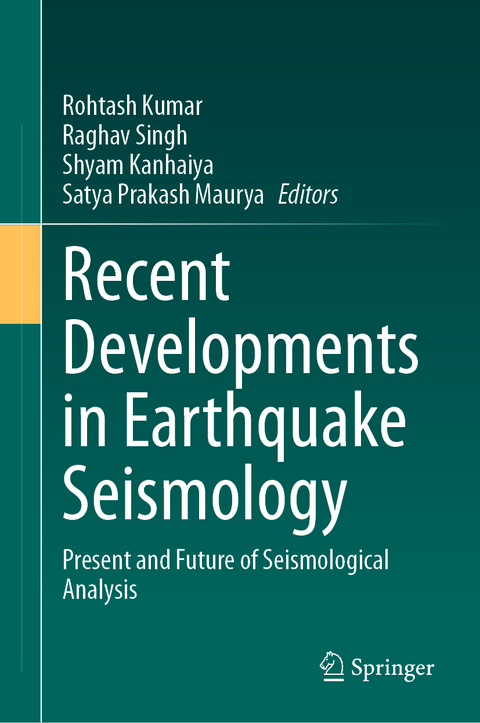
Recent Developments in Earthquake Seismology
Springer International Publishing (Verlag)
978-3-031-47537-5 (ISBN)
lt;p>Dr Rohtash Kumar is presently working as an Assistant Professor in the Department of Geophysics, Institute of Science Banaras Hindu University, Varanasi, Utter Pradesh, India. He did PhD from the Department of Earthquake Engineering, Indian Institute of Technology, Roorkee, Uttarakhand, India in 2016. Dr Kumar area of research is the earthquake source dynamics, wave propagation, moment tensor analysis and waveform inversion. He has published more than ten research papers in well reputed international journals. He is supervising six PhD students working on various aspects of seismology. He also supervises more than twelve postgraduate students in their research work. He has also engaged in various administrative works apart from teaching and research. Dr Kumar has more than 10-year experience in the field of earthquake seismology.
Mr. Raghav Singh is presently working as an Assistant Professor in the Department of Geophysics, Institute of Science Banaras Hindu University, Varanasi, Utter Pradesh, India. He did his MSc from the Department of Earth Science, Indian Institute of Technology, Bombay, Mumbai, India in 2013. Mr. Singh is also doing his PhD in the field of earthquake seismology. His area of interest is joint inversion, moment tensor analysis, and full waveform inversion. He has published four research papers in well-reputed international journals. He supervises more than 40 postgraduate students for their dissertation projects.
Dr. Shyam Kanhaiya is presently working as an Assistant Professor and Head, in the Department of Earth and Planetary Science, Rajju Bhaiya Institute of Physical Sciences for Study and Research, Veer Bahadur Singh Purvanchal University, Jaunpur, U.P., India. Dr. Singh did his PhD from the Department of Geology, Institute of Science, Banaras Hindu University, Varanasi, U.P., India. His area of interest is Geochemistry of earth surface processes: river processes geochemistry, chemical weathering of rocks, sediment geochemistry, paleoclimatology, and provenance studies besides fluvial sedimentology of the Ganga plain. He has published more than 15 research papers in well-reputed international journals. He is supervising four PhD students working on various aspects of geology. He has also engaged in various administrative works apart from teaching and research.
Dr. Satya Prakash Maurya is presently working as an Assistant Professor in the Department of Geophysics, Institute of Science, Banaras Hindu University, Varanasi, Utter Pradesh, India. He did his PhD from the Department of Earth Sciences, Indian Institute of Technology, Bombay, Mumbai, India in 2016. Dr. Maurya's area of research is Exploration Geophysics, Seismic inversion, Well log analysis, Petrophysics, Reservoir Characterization, Seismic acquisition, Processing, and Interpretation, CO2 Sequestration in Geological Formation, Optimization, Machine Learning and Geomechanics behavior of reservoir. He has published more than 25 research papers in well-reputed international journals. He has supervised one Ph.D. student and currently supervising six Ph.D. students working on various aspects of seismic methods. He also supervises more than 15 postgraduate students in their research work. Dr. Maurya has more than 10 years of research experience.Chapter 1: Earthquake Occurrence Models.- Chapter 2: Estimation and Validation of arias intensity relation using the 1991 Uttarkashi and 1999 Chamoli earthquakes data.- Chapter 3: Exploring the Concept of Self-Similarity and High-Frequency Decay Kappa-Model and fmax-Model Using Strong-Motion Surface and Borehole Data of Japan: A Statistical Approach.- Chapter 4: Body waves and Surface waves derived Moment Tensor Catalog for Garhwal-Kumaon Himalayas.- Chapter 5: Exploring GRACE and GPS, and absolute gravity data on the relationship between hydrological changes and vertical crustal deformation in south India.- Chapter 6: Moho mapping of Northern Chile Region using receiver function analysis and HK stacking.- Chapter 7: Coulomb Stress Change of the 2012 Indian Ocean Doublet Earthquake.- Chapter 8: Earthquake source dynamics and high frequency decal characteristics of Japanese arc region.- Chapter 9: Lapse-Time Dependence of Coda Quality Factor Within the Lithosphere of Northern Ecuador.-Chapter 10: Coda Q estimates of the Bilaspur region of Himachal Lesser Himalaya.- Chapter 11: Data-driven spatiotemporal assessment of seismicity in the Philippine region.- Chapter 12: Determination and identification of focal mechanism solutions for the 2016 Kumamoto Earthquake from waveform inversion using ISOLA software.- Chapter 13: Regression Relations for Magnitude Conversion of Northeast India and Northern Chile and Southern Peru.
| Erscheinungsdatum | 06.03.2024 |
|---|---|
| Zusatzinfo | XX, 192 p. 128 illus., 111 illus. in color. |
| Verlagsort | Cham |
| Sprache | englisch |
| Maße | 155 x 235 mm |
| Themenwelt | Naturwissenschaften ► Biologie ► Ökologie / Naturschutz |
| Naturwissenschaften ► Geowissenschaften ► Geologie | |
| Naturwissenschaften ► Geowissenschaften ► Geophysik | |
| Schlagworte | Earthquake Simulation • Earthquake source dynamics • Global Optimization Methods • Seismic hazard and risk • Seismology • Topography • waveform inversion |
| ISBN-10 | 3-031-47537-2 / 3031475372 |
| ISBN-13 | 978-3-031-47537-5 / 9783031475375 |
| Zustand | Neuware |
| Informationen gemäß Produktsicherheitsverordnung (GPSR) | |
| Haben Sie eine Frage zum Produkt? |
aus dem Bereich


